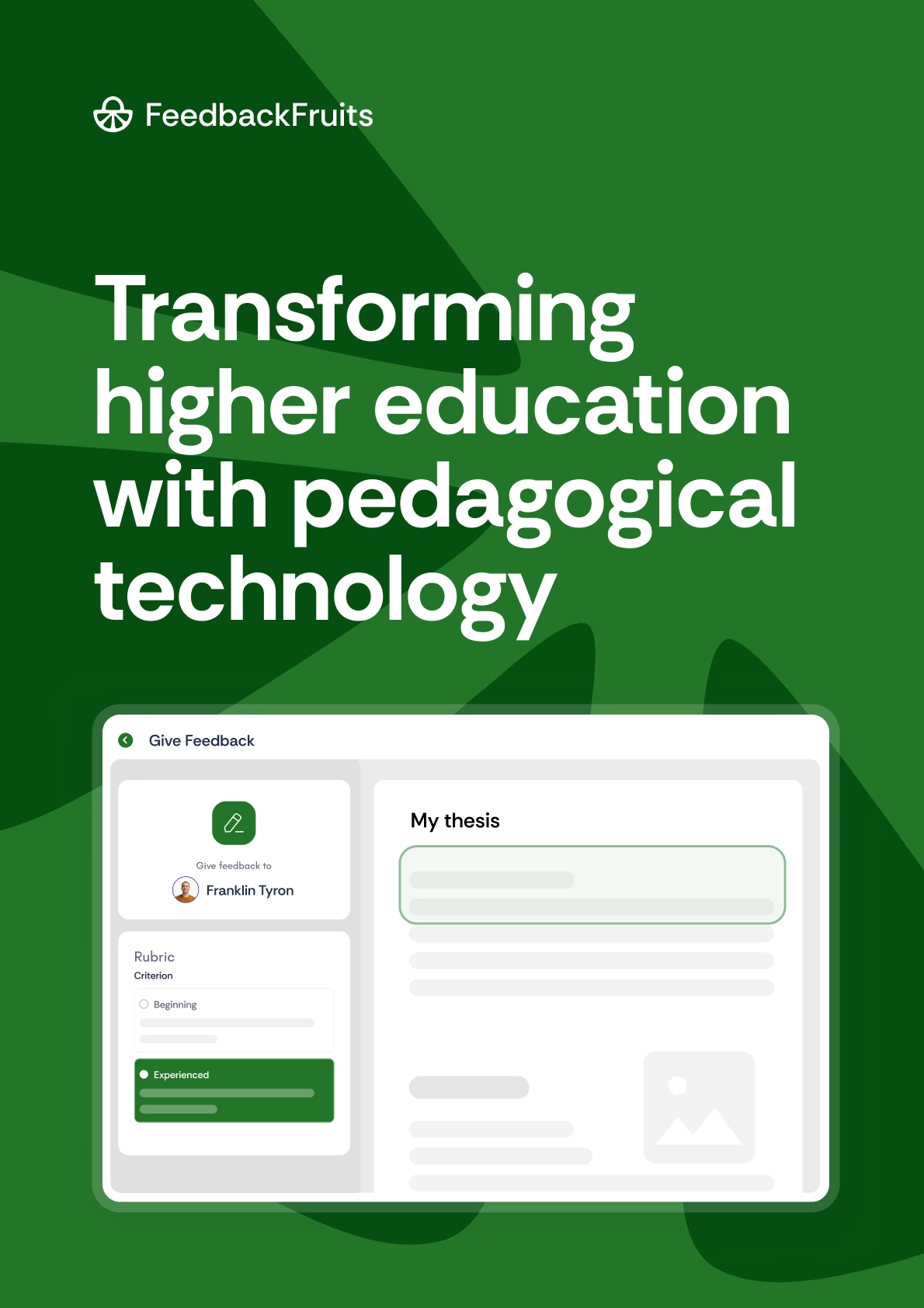3 pedagogical benefits of FeedbackFruits Discussion Tools
The future is here and now, more than ever, is the time to address the new world of knowledge acquisition and present that very world to students. The unprecedented rate at which the world is moving forward requires students to be able to navigate and manage the complexities of society. It creates an urgency for teaching and learning approaches to generate a new generation of lifelong learners.
These future lifelong learners should be prepared to understand the way knowledge is interconnected with the help of a teaching methodology that can guide them. This manner of knowledge acquisition places the student at the centre and this blog explores the way that FeedbackFruits tools contribute to this new form of obtaining knowledge.

The transition from direct instruction to learner-centered approaches to learning
Pedagogy refers to the method of how we teach and the practice of educating [1]. In the current educational landscape, educators have put emphasis on meaningful classroom interaction with their learners. This entails building on a student's prior knowledge and learning process, as well as developing students critical thinking, which aids in constructing alternative solutions to the multitude of complex societal problems. One efficient way of the acquisition of critical thinking is through active learning pedagogy. This methodology aims to switch from the traditional direct instruction, usually in the form of lectures, to a more student-centered one [1]. Now more than ever educators and instructors have been witnessing the benefits of such an approach with the aim of moving students beyond simple forms of thinking, as defined by Bloom's Taxonomy, to promote higher order forms of thinking.

Why the need for active learning?
Active pedagogical strategies aid in the acquisition of critical thinking skills opposed to passive learning. This is the case as passive learning moments entail a lethargic transfer of information from teacher to student, which mainly focuses on memorization of someone else's line of reasoning [2]. Active learning pedagogies promote critical thinking by promoting liberation of thought and challenging dominant ways of thinking. Students are free to reconstruct alternative solutions and generate innovative approaches that will aid in finding solutions in the myriad of complex societal problems that might be presented to students in the future [2] .
An example: How Discussion tools contribute to active pedagogical strategies
FeedbackFruits tools can contribute to active learning in various ways. FeedbackFruits Discussion on Work and Discussion on Topic help in critical thinking by allowing teachers to structure a meaningful online discussion. Students are asked to take part in a discussion online as well as review the work of their peers. In a more open environment, students can comment on all input, once there is enough activity teachers participate and guide the discussion.
1 - Self-reflection helps students apply new knowledge
The self reflection moment in Discussion tools is incorporated when students review their peers' work, their own work as well as the advice of the teacher. Self reflection helps students develop strategies to apply new knowledge to complex situations in their day to day activities. Students can develop a higher order way of thinking by relating new knowledge to prior understanding as well as thinking in both abstract and conceptual terms. Self reflection also helps in critical thinking by applying specific strategies in novel tasks and lastly understanding one's own thinking and learning strategies [3].
2 - Have debates to improve critical thinking
Discussion tools can also stimulate the promotion of debate. Succeeding the process after a teacher opens up an online discussion, a student is able to review the input of their peers and make their own contribution to the online discussion by bringing their own perspective into the dialogue [1]. As students' opposing arguments are put forward in an effort to argue for opposing viewpoints this stimulates debate. Students then learn to evaluate and analyze arguments to determine which have merit. Debate also promotes the ability to make reasoned and well thought out arguments in addition to questioning the evidence behind a particular stance. Debate also enhances critical advocacy which is a vital trait that citizens in a society should be able to cultivate [3].
3 - Collaboration is the key for intellectual development
Lastly, by students being able to review the input of their peers as well as make their own contribution to the work this stimulates collaborative skills. Collaborative skills also aid in critical thinking. Specifically, the construction of new knowledge is often built during students' experiences when working with others in a collaborative learning process such as when working on the Discussion tools. Through social interaction, cognitive conflicts occur and ultimately a disequilibrium in students thoughts, which in turn spurs intellectual development. When members of a group are exposed to the intellectual diversity of others, they are then confronted with innovative or different ways of looking at familiar problems [3].
Closing Remarks
In this information age, students need to cultivate through an immense amount of information in the collegiate environment as well as in the real world setting. By incorporating active learning methodologies such as self reflection, debate and collaborative skills which in turn cultivate critical thinking abilities, this assists students to be able to handle the exponential rate of innovation and information development.
References
[1] Tedesco-Schneck, M. (2013). Active learning as a path to critical thinking: Are competencies a roadblock? Nurse Education in Practice, 13(1), 58-60. https://doi.org/10.1016/j.nepr.2012.07.007
[2] Boyd, B. L., & Pesl Murphrey, T. (2002). Evaluation of a computer-based, Asynchronous activity on student learning of leadership concepts. Journal of Agricultural Education, 43(1), 36-45. https://doi.org/10.5032/jae.2002.01036
[3] Loes, C. N., & Pascarella, E. T. (2017). Collaborative learning and critical thinking: Testing the link. The Journal of Higher Education, 88(5), 726-753. https://doi.org/10.1080/ 00221546.2017.1291257
















![[New] Competency-Based Assessment](https://no-cache.hubspot.com/cta/default/3782716/interactive-146849337207.png)










